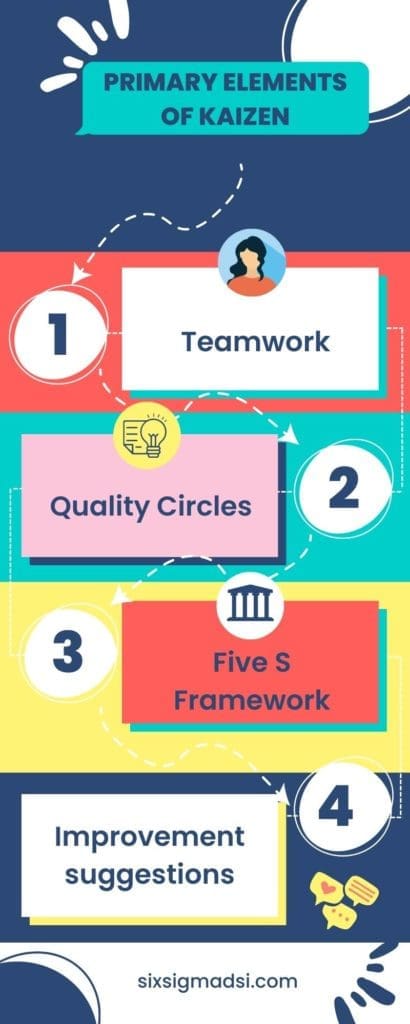Table of Contents:
- What is a Kaizen Coach?
- F.A.C.T. Represents the coaching system and consists of four steps
- Application of Kaizen coaching model with support delivers benefits
- What is Kaizen training?
- Kaizen: 10 Principles
- How Kaizen works
- Continuous improvement through Kaizen Cycle
- Different types of Kaizen training events
- Kaizen 5S training framework
- Kaizen’s training advantages and disadvantages
- Kaizen coaching examples
- Related articles
What is a Kaizen Coach?
Kaizen Coaching is a personal, business, and professional development strategy that uses training models and creates resilient, agile leaders who can turn challenges into new opportunities to propel personal growth and achieve strategic results.
The Kaizen Coaching Model acknowledges the need for internal and external reality to be heeded, addressed, and integrated. We must take full responsibility for our actions and choose to change our reality. Two fundamental insights are the basis of this model:
- Change can manage our physical world. Change can be made to our physical world.
- However, our psychological world can only be managed through choice.
F.A.C.T. Represents the coaching system and consists of four steps
- Search Centre – Feel what you’re feeling. Breathe and center your consciousness. Find and nurture your inner authentic self. This is the place. Throughout the entire process, you can return to your center at any time. Radiate authentic self. By centering your consciousness, you can ensure that the conscious choices made are in alignment with your vision, values, and purpose.
- Accept reality. Observe objective characteristics. Refuse to take two steps back. Listen, observe, and perceive with no bias. Be open, transparent, and reflective. Give context to the problem. Accept reality and find your center. Change your perspective. Recognize your assumptions. Accept responsibility. Accept responsibility
- Look at the Options and Select. What are you looking for? Think of possibilities. What is the future? What opportunities/options are the most enticing/promising? Take into account the potential impacts. Consider all options. Transform challenges into opportunities To reflect, and center your consciousness. Make a choice.
- Take Action: – Establish direction and create a strategy. Focus. Determine the key milestones that are important and then determine the next steps. Set up success indicators and an accountability system. Prepare resources. You can feel confident knowing that your coach is always available by phone or email. Experience. Document what inspires you and makes you feel good. Give an update during the next coaching session.

Application of Kaizen coaching model with support delivers benefits
- A greater sense of self-worth and integrity, as well as improved mental outlook, concentration, creativity, and coping skills.
- Increased self-awareness and alignment of vision, values, and actions. Clear goals and action plans that encourage strategic action and deliver results.
- You will have a higher level of work performance and more energy.
What is Kaizen training?
A Kaizen model is a method of continuous improvement that focuses on small, positive changes that can lead to significant improvements. It is typically based on cooperation, and commitment, and contrasts with top-down transformational approaches. Kaizen is the core of lean manufacturing and The Toyota Way. It was created in the manufacturing industry to reduce defects, eliminate waste and increase productivity.
It is a broad concept with many interpretations and has been used in many industries, including healthcare. It can be used in any industry and at any level. There are many tools and approaches to Kaizen. These include value stream mapping which documents, analyses and improves information flows or product production — and total quality management which enlists all workers to work towards improving quality. No matter what method you use, Kaizen is only successful in an organizational setting if there is support from all levels of the organization.
A Kaizen model is a combination of two Japanese words which translate to “good change” and “improvement.” Kaizen, however, has been interpreted as “continuous improvement” because of its association with lean principles and methodology.
Kaizen was born in post-World War II Japanese quality circles. These groups or circles of workers were focused on preventing Toyota defects. These circles were created partly as a response to American productivity consultants and management who visited Japan, particularly W. Edwards Deming who believed that quality control should be more directly in the hands of line workers. Masaaki Imai’s book Kaizen, The Key to Japan’s Competitive Successin 1986 brought Kaizen to the West.
Kaizen: 10 Principles
Kaizen is about fostering a culture of excellence in a company. These 10 principles are often referred to as the core of the philosophy. These are:
- Don’t hold on to your assumptions.
- Take initiative to solve problems.
- Do not accept the status quo.
- Don’t be a perfectionist and adopt an attitude that is iterative and adaptive.
- As you make mistakes, look for solutions.
- Make sure everyone feels empowered to make a contribution.
- Do not accept the obvious problem; instead, ask five times “Why” to find the root cause.
- Collect information and opinions from many people.
- You can use your creativity to make small, low-cost improvements.
- Never stop learning.
How Kaizen works
Kaizen is based upon the belief that anything can be improved and nothing should remain the same. It is also based on the Respect for People principle. Kaizen is about identifying problems and opportunities, creating solutions, and rolling them out. Then, you cycle through the process for any issues or problems that have not been addressed. This cycle can be used to continuously improve and provide a method of executing the process. It consists of seven steps.

Continuous improvement through Kaizen Cycle
Kaizen can be applied in seven steps to creating an environment that encourages continuous improvement. These steps are part of this systematic approach:
- Engage employees. Ask employees for their involvement, and ask them to help you identify problems. This will encourage employees to support change. This is often done by establishing specific groups of people who are responsible for gathering and relaying information from a larger group of employees.
- Collect feedback from employees to identify problems and possible solutions. If there are multiple issues, create a list.
- Find a solution. Inspire employees to come up with creative solutions. Choose one or more winning solutions from the suggestions.
- Use the solution to test it. Have everyone involved in the rollout. To test the solution, create pilot programs.
- Review the results. Make plans to monitor progress at various times. Develop specific plans that will identify who will be the point of contact and how to keep workers on the ground engaged. Find out how successful the change was.
- Positive results can be adopted throughout an organization.
- These seven steps need to be repeated regularly, with new solutions being tested as necessary or new problems being tackled.
There are other ways to approach the Kaizen cycle, including one that can be condensed into just four steps: plan do check, and act. It is also called the Deming cycle or Shewhart cycle.
Different types of Kaizen training events
Kaizen’s models goal is to promote cultural change. However, Kaizen events can be used to kick-start these efforts or address a particular set of problems.
Kaizen is a concentrated effort to make short-term changes in order to reach a goal. Kaizen blitz is a name that’s often associated with Kaizen events. It includes Kaizen burst and Kaizen workshop. Continuous improvement workshops, Kaizen workshops, Kaizen workshops, Kaizen workshops, and rapid-process workshops are all examples. These events can use a variety of tools or be focused on specific areas such as the 5S Framework, total productivity maintenance, and Value stream mapping.
Kaizen 5S training framework
The Kaizen system is incomplete without a 5S framework. It creates a perfect physical workplace. The 5Ses are focused on visual order, organization, and cleanliness to increase profitability, efficiency, and safety. Below is a list of the 5Ses in Japanese and their English translations.
- Sort (organize). Separate the essential workplace items from the unnecessary and get rid of them.
- Set in order/Create orderliness. Arrange items so that they are easy to find in a way that makes sense for your work.
- Cleanliness/Shine
- Seiketsu/Standardize (standardized cleaning). Systematize workplace cleanup best practices.
- Sustain/Shitsuke (discipline). Keep going.
Kaizen’s training advantages and disadvantages
Kaizen can be a great tool for organizations for many reasons. However, it’s not always the best fit for every situation. These are some of Kaizen’s benefits and drawbacks:
Kaizen advantages
- Kaizen’s emphasis on gradual improvement can lead to a more gentle approach to change than big efforts that might be abandoned because of their tendency to cause resistance and pushback.
- Kaizen encourages the examination of processes to reduce waste and mistakes.
- There are fewer mistakes, which means that oversight and inspection requirements can be reduced.
- Kaizen promotes a sense of value and purpose, which improves employee morale.
- Employees think beyond their departments to increase teamwork.
- Employees become more attentive to customer needs, which increases client focus.
- To encourage improvements in both the short- and long-term, systems are in place.
Kaizen disadvantages
- Closed communication cultures and companies with a culture of territorialism may need to first focus on cultural changes in order to create an environment that is more open to new ideas.
- Kaizen events that are short-term may cause a temporary burst of excitement, but it is usually not sustainable.
Kaizen coaching examples
Toyota is the most well-known company for using Kaizen training. However, other companies have also successfully applied the method. These are just three examples.
- Lockheed Martin. This aerospace company is a strong proponent of Kaizen training. The company has successfully used Kaizen to reduce manufacturing costs, inventory, and delivery times.
- Ford Motor Company. In 2006, Ford was in danger of going bankrupt. Mulally used Kaizen for one of the greatest corporate turnarounds in human history.
- Pixar Animation Studios. Pixar used a continuous improvement to decrease the risk of costly movie failures by using quality control checks, iterative processes, and iterative procedures.



















